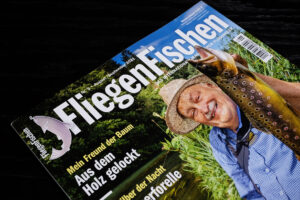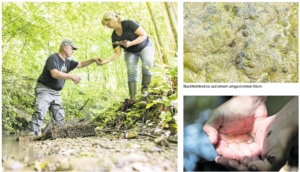In the current Petri Heil you will find a report about my feed baskets.

Transcript
Feed baskets | Creating habitat for small animals
Stefan Baur has dedicated himself to the production of feed baskets for flowing waters. "Petri-Heil" visited the inventor and enthusiastic fly fisherman in Safenwil.
If the fine sediments in a river are not regularly washed away, they settle in the riverbed and harden the bottom of the water. This makes it difficult for macrozoobenthos such as freshwater shrimp, caddisflies and stoneflies to find a suitable habitat. And where the macrozoobenthos are in decline, the fish are missing an extremely important food source. This hardening process, known in technical terms as colmatization or colmation, is an increasing phenomenon in our rivers. This is not only because structures interrupt the dynamics of the sediments, but also because precipitation has noticeably decreased in many places in recent years, thus limiting the self-cleaning power of the streams and smaller rivers. For several years, resourceful fishermen in Aargau have been experimenting with a process originally developed in Sweden to mitigate the negative effects of colmatization.
Straw as a food source
Gammarus in particular feed mainly on dead, organic material, known as detritus. This makes them the caretakers of streams and rivers. For example, fallen leaves that sink to the bottom of the water in autumn are broken down by these small animals. Where there is plenty of food (and the water quality is good), they multiply well, and in turn, fish of all ages benefit from this. In addition to food, these animals also need a suitable habitat. Straw in feed baskets is ideal for this in two ways: the hollow straws are easy for the larvae and freshwater shrimps to colonize and provide a rich food source. At the same time, the long stalks stay well in the mesh basket and are not washed out. A correctly placed feed basket with the right mesh size is a perfect habitat for the macrozoobenthos. Another advantage is that straw from straw bales is tightly pressed, so it takes quite a while for such a basket to be empty. The small creatures obviously feel comfortable in the straw; when you check the feed baskets, you can see a lot of activity, and after about four months, a basket like this is completely eaten and can be refilled, says Baur.
Step by step to success
After a few attempts, stable, refillable feed baskets made of steel with a mesh size of two to three centimeters have produced the best results. Experiments with jute or potato sacks, on the other hand, were much less successful, but the fishermen are still experimenting. But the location is more important than the mesh size or the material, stresses Baur. Firstly, there needs to be enough current and secondly, the water needs to be deep enough so that the basket is completely underwater all year round. The baskets, which Stefan Baur produces in collaboration with the gardeners at Lehnert AG in Wöschnau, have a mesh size large enough to allow young fish to find their way inside. They instinctively accept the welcome source of food, so young trout, bullheads and other smaller fish, as well as dragonfly larvae and predatory caddisfly larvae, can be found directly in the feed baskets; even the young salmon introduced into the Bünz helped themselves to the rich buffet of macrozoobentos. The baskets also provide the small fish with an ideal hiding place from predators of all kinds. The increase in food animals is not limited to the immediate area around the baskets. Food animals are constantly being carried along by the current and are a welcome source of food for the trout further downstream.
Doubling of earnings possible
Stefan Baur is still amazed at how successful the feed basket concept is. "We initially did not think it possible that the baskets would double trout yields. We can now guarantee this if the baskets are installed properly." How exactly the baskets are anchored, what size baskets should be chosen, and at what intervals and locations the baskets are ultimately placed varies from body of water to body of water. "If there is enough oxygen, food and shelter, good brown trout populations are still possible in the Mittelland," Baur is convinced, pointing to the Aargau waters in which he is a leaseholder.
Information
Stefan Baur offers the feed baskets for sale and is happy to help with advice and implementation. Interested clubs or tenants can contact him by phone or email: kontakt@futterkorb.ch, 079 404 24 62.
Further information on the subject of macrozoobenthos and feed baskets can be found in the newly published “The Great Revitalization Book” by Roland Herrigel.


